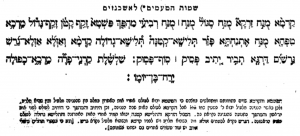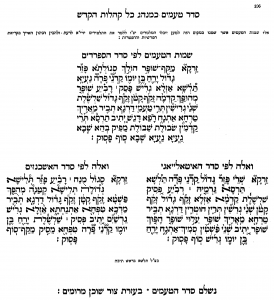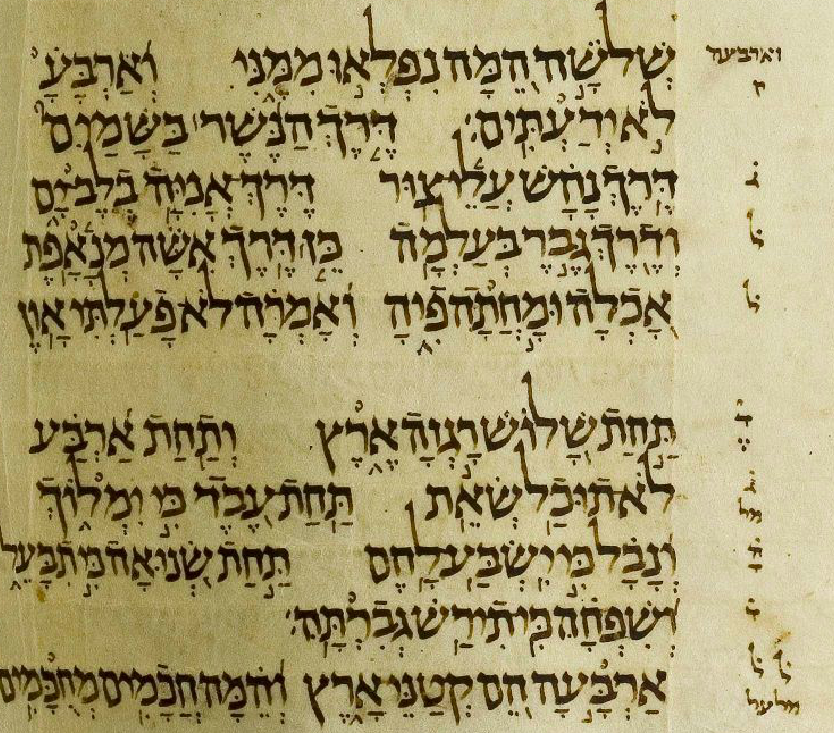קַדְמָ֨א מֻנַּ֣ח זַרְקָא֮ מֻנַּ֣ח סֶגּוֹל֒ מֻנַּ֣ח ׀ מֻנַּ֣ח רְבִיעִ֗י מַהְפַּ֤ךְ פַּשְׁטָא֙ זָקֵף קָטָ֔ן
זָקֵֽף־גָּד֕וֹל מֵרְכָ֥א טִפְּחָ֖א מֻנַּ֣ח אֶתְנַחְתָּ֑א פָּזֵ֡ר תְּלִישָֽׁא־קְטַנָּה֩
תְּ֠לִישָֽׁא־גְדוֹלָה קַדְמָ֨א וְאַזְלָ֜א אַזְלָא־גֵּ֜רֵשׁ גֵּרְשַׁ֞יִם
דַּרְגָּ֧א תְּבִ֛יר יְ֚תִיב פְּסִיק׀ מֵרְכָ֥א טִפְּחָ֖א מֵרְכָ֥א סֽוֹף־פָּסֽוּק׃
שַׁלְשֶׁ֓לֶת קַרְנֵֽי־פָרָ֟ה מֵֽרְכָ֦א־כְּפוּלָה יֶֽרַח־בֶּן־יוֹמ֪וֹ׃
זַרְקָא֮ מַקַּף־שׁוֹפָר־הוֹלֵ֣ךְ סְגוֹלְתָּא֒ פָּזֵר גָּד֡וֹל
תַ֠לְשָׁא תִּ֩ילְשָׁא אַזְלָ֨א גֵּ֜רֵישׁ פָּסֵק׀ רָבִ֗יעַ שְׁנֵי־גֵרֵישִׁ֞ין
דַּרְגָ֧א תְּבִ֛יר מַאֲרִ֥יךְ טַרְחָ֖א אַתְנָ֑ח שׁוֹפָר־מְהֻפָּ֤ךְ
קַדְמָא֙ תְּרֵ֨י־קַדְמִין֙ זָקֵף־קָט֔וֹן זָקֵף־גָּד֕וֹל שַׁלְשֶׁ֓לֶת
תְּרֵי־טַעֲמֵ֦י יְ֚תִיב סוֹף־פָּסֽוּק׃
זַרְקָא֮ שְׁרֵ֒י פָּזֵ֡ר גָּדוֺל֡ קַרְ֟נֵי פָרָ֟ה תַּלְ֠שָׁא
תַּרְסָא֩ גַרְמֵ֤יהּ ׀ רְבִ֗יעַ פְּ֤סִיק שַׁלְשֶׁ֓לֶת
קַדְמָ֨א אַזְלָ֜א זָקֵ֕ף גָּד֕וֹל זָקֵ֔ף קָטָ֔ן
שְׁנֵ֞י גְרִישִׁ֞ין תְּרֵ֦ין חוּטְרִ֦ין דַּרְגָ֧א תְּבִ֛יר
טַרְחָ֖א מַאֲרִ֥יךְ שׁוֹפָ֣ר עִלּ֣וּי שׁוֹפָ֤ר הָפ֤וּךְ
שׁוֹפָר יְ֚תִיב שְׁנֵ֨י פַּ֙שְׁטִין סְמִיךְ־אַתְנָ֑ח
יָרֵ֪חַ בֶּ֪ן יוֹמ֪וֹ גְּרִ֜ישׁ סֽוֹף פָּסֽוּק׃
We are sharing these tables for Taamei haMikra (cantillation for Torah reading) because we weren’t able to find these available in Unicode Hebrew text anywhere else on the Internet. We would very much like to also share the traditional tables of Taamei haMikra for the Nusaḥ Italki (Italy), Nusaḥ Teman (Yemen), and others along with excellent free-culture licensed recordings of these tables being chanted. Unfortunately, there is a paucity of free-culture licensed audio and video of the taamei hamikra being chanted. Please help us by sharing your audio or video with a Creative Commons Attribution license.
Sources
Recordings
Isabel Bard (Shemot ha-T’amim l’Ashkenazim):

“טעמי המקרא | Cantillation Tables for Torah Readings” is shared through the Open Siddur Project with a Creative Commons Attribution-ShareAlike 4.0 International copyleft license.










Now appears here too:
https://he.wikisource.org/wiki/%D7%9E%D7%A9%D7%AA%D7%9E%D7%A9:Dovi/%D7%AA%D7%95%D7%A8%D7%94_%D7%A2%D7%9C_%D7%A4%D7%99_%D7%94%D7%9E%D7%A1%D7%95%D7%A8%D7%94/%D7%A9%D7%9E%D7%95%D7%AA_%D7%94%D7%98%D7%A2%D7%9E%D7%99%D7%9D
Shabbat Shalom
All of the following observations pertain to the Ashkenazi list.
Nice work, having the ashkenazi list begin with qadma, not the erroneous pashta so often seen in that position. But the qadma note itself needs to be positioned on top of the mem of the word “qadma”, not the alef ! That makes it a pashta, meaning that you’ve only fixed half the problem, and have confused the issue even more. :-(
Thanks too for writing “revia” not “revii”, another egregious and pervasive error in many such lists.
And for not putting a munah on the word “zaqef” of “zaqef qatan”, another oft-seen error.
On the other hand, why do telisha qetanah and azlah geresh and zaqef gadol have intervening maqqef, as expected, but other compound names, such as telisha gedolah and zaqef qatan in your list do not?
corrected. I’ve also added the source images from which the tables were derived.
Aharon, thanks for corrections and the sources! I notice that compared to the 1904 source a few things are in a different order and which things are considered compound and have a hyphen is still a little inconsistent. But unless you’re trying to transcribe the 1904 with errors, that’s probably fine. For example, the 1904 doesn’t have a makef (hyphen) in zakef katon, but also the vowel that should be a tzere below zekef in zakef katon isn’t clear. But I assume the transcription is correct and the original is wrong there. I’m also going to assume the exact order is not any particular tradition.
They mystery around revi’i/revi’a deepens though. The 1850 source does show revi’a in all 3 traditions, but the 1904 Ashkenazi text shows revi’i. It would be interesting to find out how or why that change? But for purposes of learning and teaching cantillation, it seems like the word has changed over time and revi’i is what is used to day. (Actually, the Unicode text above just leaves out that vowel, was that was intentionally Solomonic or a mistake?)
Which brings up bigger discussion about preserving what’s traditional vs. changing things. It’s really cool to see these old resources and even new things in the old style, but I also feel like there other more interactive ways these could be done now (e.g., through colors, recordings, interactivity, design). Maybe I’ll get to working on that at some point…
Can you provide some more background on what this chart is and what makes the Ashkenazi and Sephardi version different? I gather that these are the names of the ta’amei ha’mikra listed in an order that they are in printed tikkuns. The actual symbols are not ashkenazi or sephardi so why do the have different arrangements or names? Moreover, this is not necessarily how I learned so is there some significance to this “traditional” order?
Yes, the kadma is misplaced on the first kadma, and I’d also agree about adding makef to telisha gedolah and zakef katan. Actually, since this is just Unicode I’m going to copy and paste that into a new doc send that to you!
@Todd.Shandelman: What do you mean about “revia” vs. “revii” and do you have a source for that? I ask because I checked couple books from current reputable publishers (on the Reform side, the Wolff/Portnoy manual from URJ and on the Orthodox side, Tikkun Simanim from Feldheim) and they all have the second chirik to read “revii”.
Speaking of which, there are some other minor differences between the Ashkenaz version here and my Tikkun Simanim, but I don’t know that they are wrong as opposed to just a slightly different arrangement by a different editor.
If you want the commenter notified of your reply, make sure to reply directly to commenter’s comments by using the reply link next to their comment’s timestamp.
Todd Shandelman explained this further to me as follows:
So about ‘revi`a’ vs. ‘revi`i’.
It is not hard to notice that many if not most of the names of the te`amim / cantillations in the typical lists are (1) Aramaic, or of Aramaic origin. (2) Words referring somehow to some position of a body.
E.g.: (translations are very approximate, not precise):
munnah, etnahta = at rest;
zaqef = standing straight
pashta = extended
mahpakh = inverted
qadma ve-azla = advancing
Now, ‘revi`i’ is a common Hebrew word meaning “4th”. But what sense does that make as the name of a cantillation symbol? None really.
On the other hand, ‘revi`a’ is an Aramaic word corresponding to the Hebrew “rovetz,” lying down (of an animal, usually, but maybe not always). This can be seen very clearly in Targum Onkelos to Shemot 23:5.
Bingo! Now we have yet another cantillation with a name indicating a bodily position, which makes quite a lot of sense in the context of all the other examples, as enumerated above.
The printers were generally ignorant of Aramaic, apparently, or did not recognize the the word “revia`”, at least. So it seems they assumed that “revi`a” was an error, and they “corrected” it to “revi`i”. Ouch.
But “revi`a” is the way to go.
Todd made the follow request regarding posting this here:
1. Please credit me by name.
2. Please do not change anything I wrote; post it exactly as I wrote it.
Yes, revi’a is right. The tsaddeh-to-ayin change from Hebrew to Aramaic occurs in, for example, eretz becoming ar’a. “ravatz k’aryeh” in the blessing of Yehuda in B’reshit 49: = he crouches like a lion, shows the descending motion of the revia in almost all the leyening traditions.
Does anyone have an open source for the actual staff-music for any of these? I have only been able to find the Reform staff music so far.
My book: The Music of the Hebrew Bible is the standard primer with history, analysis and music of all six systems for the .western Ashkenazic tradition (which we believe to predate the style now adopted in USA and Israel). I would be happy to send a copy, if of interest.
Hi Victor, I’d love to get your book — it seems to be out of stock everywhere. How can I buy it?
Unfortunately Mr Tunkel passed away in July 2019 and it appears that the book is out of print. But if you are patient, second-hand copies occasionally come up. I found a copy on AbeBooks.
I’ve been meaning to add links to the tributes written in memory of Victor Tunkel. He was an active commenter on a number of posts here at the Open Siddur Project website.
A memoir at the Seldon Society: https://www.seldensociety.ac.uk/feature/fifty-years-mile-end-memoir/
Tribute by the European Cantors Association: http://www.cantors.eu/VictorTunkelTribute.html
The Jewish Encyclopedia has a zarqa table in European staff notation for Sephardi, West-Ashkenazi, and Mizrahi tropes known in 1902, including a year-1518 Ashkenazi Torah trope.
Various Ashkenazi tropes can be found if you fish around for Jeffrey Burns’s website, which is only preserved via archive . org since he died. But I’m continuing his work, at the moment…
Please keep us in the loop. Whatever we can do to help, let us know.
Yes! Thankyou for welcoming me. I’m working a payed internship, right now, to organize my research, and begin arranging The Book of Job (a passion-project of mine). The consequent effort I’ve started, while pursuing it, this on developing a working model of poetical chant, seeking to reconcile the various traditions of cantillation. I even want to find what material I can on sidre-miqrata (Samaritan cantillation), since it sounds alot like a lesser-known Lithuanian trope, but harmonized in a minor key.
But I read that Samaritan accents preserve instructions for volume and speed, which t’ammim are aledged to have done in former times.
Here is an example of this work, applying a Lithuanian Torah trope to Psalm 90, giving myself some freedom of movement in the performance. But I respect the form of the trope at all times, and sing every accent.
https://www.facebook.com/587521941/videos/10159020058266942/
Checking myself- I do snip Sof-pasuk to be either a rise or a fall, depending on the silluk. Some verses call for it. Regardless, Psalm 90 is intricately accented and not a short one! Was hard to practice, and I don’t know if I’ll ever be experienced enough to satisfy myself by a performance.
Hi, how can I get ahold of Jeffrey Burns’ half-finished book “Music of the Psalms, Proverb, and Job?” Also can’t seem to find that archived web page you mention
I will link my sources for my internship, but pending that organizational labour, I will link you to my own Google Drive for Jeffrey Burns’s notated zarqa tables for each representative of Ashkenazi prose traditions of chant.
https://drive.google.com/drive/folders/1TdsvTOcN6ZroCNoqtvbg25Nr3qsbNat5?fbclid=IwAR3JILQ2Z1CJfH9JC19onArDVbj02M3mXvWTKjZOmfqFmf_acmaYHVwAU_c
They are part of the public domain.
But I would rather not share my digital copy of his book publicly, since it is copywrited (although out of print).
I got my copy from my university’s library. Any books which my library does not have (for the most part), I was able to get by International Library Loan, through my university.
I have further annotated his tables to illustrate the t’ammim in colour on the musical stave to accompany and help internalize the motifs. But I’ll only put those versions out as part of my project, since it takes time to scan. I’m already taking a long time to make a machine-translation of someone’s German PhD thesis in comparative Psalmody.
https://drive.google.com/drive/folders/1PdDmjupXExI56eilbfYlSlOcAU-Ifk3N?usp=sharing
I will also share the early recordings I made of tutorials for singing the Torah trope which I was teaching myself, at the time (with the help of Jeffrey’s book as well as his transcribed tropes.)
It could be better, since I was recording them as I was learning. But it’s better than having the sheet music without any instruction.
Thank you for your amazing work, Aharon (and everyone else).
One question: For the Ashkenazic chart of te’amim, shouldn’t the words of the phrase “yare’ah ben yomo” be separated by hyphens?
Thanks Avi and Shavua tov. Sometimes the trōp mark yeraḥ/yaréaḥ ben yomo appears with a maqaf and sometimes it does not, as we can find in the two sources I have included (from 1904 and 1906). I’d like to know the significance of this variation, if there is any.
Final sheva missing in מַהְפַּ֤ך (technically not needed but I think it is usually supplied).
The marks segol and xataf patax on yod and resh in יֶרֲח־ should probably be segol-meteg and patax, i.e. יֶֽרַח־.
A shin dot is missing in תְּלִישָא־ both times it appears.
Apologies if this is redundant: seems like some of my previous comments didn’t get through, so this will be redundant if they do eventually get through.
So far, we only see your previous comment on the final sheva missing in mahpakh (since corrected). In addition to your corrections, please note if the error you found appears in the source image from which the transcription was derived, or whether it is an error of transcription, or whether it is a correction based on other sources — and thank you!
Thanks Aharon. I’m not sure if your request for correction “provenance” was only for future corrections or also for the corrections I already submitted, but, for the record, the one מהפך and two תלישא corrections (three total) are corrections to the transcription of the 1904 Miqraot Gedolot source image. I.e. the transcription was in error, not the source image.
As for the ירח־ correction, the source image is too blurry to say for sure, but I can say that my suggestion is a more plausible transcription of the source image than the “illegal” pointing that was there before (a חטף פתח can’t really be used that way). There is also circumstantial evidence for meteg because of a wider pattern in the source image, where meteg is used in 7 out of 8 accent names that are maqaf compounds.
Some of those meteg marks are missing from the transcription, BTW. (A general suggestion: I think it needs to be established how “diplomatic” (literal) a transcription this is intended to be. Perhaps a list of known (i.e. intentional) divergences from the source image would establish this.)
Here’s a review of the 8 accent names that are maqaf compounds in the transcription, and the one accent name that is a maqaf compound in the original but not the transcription:
זָקֵ֣ף־קָטָ֔ן This appears as two separate words (i.e. not a maqaf compound) in the original. From the comment history, I’d guess that the maqaf was added by “the Hierophant”, prompted by a question of why it was not present, posed by todd.shandelman@gmail.com. It is transcribed with a מנח currently, despite the fact that, way back when, Todd Shandelman said “[Thanks] for not putting a munah on the word “zaqef” of “zaqef qatan”, another oft-seen error.” Perhaps back then it did not have a מנח, even though it does now? The original is too blurry to say for sure whether there is a מנח there. A separate question is whether, given the addition of the maqaf, a מנח is still appropriate, even assuming a מנח was there originally.
זָקֵֽף־גָּד֕וֹל This seems like the most plausible transcription of the original.
תְּלִישָׁא־קְטַנָּה֩ This lacks what appears to be a meteg under the shin in the original.
תְּ֠לִישָׁא־גְדוֹלָה This lacks what appears to be a meteg under the shin in the original.
אַזְלָא־גֵּ֜רֵשׁ This seems like the most plausible transcription of the original. This is the only maqaf compound in the original that does not have a meteg.
סֽוֹף־פָּסֽוּק׃ This seems like the most plausible transcription of the original.
מֵרְכָ֦א־כְּפוּלָה This lacks what appears to be a meteg under the mem in the original.
יֶֽרַח־בֶּן־יוֹמ֪וֹ This now seems like the most plausible transcription of the original.
קַרְנֵי פָרָ֟ה׃ This is the one accent name that is a maqaf compound in the original but not in the transcription. This lacks what appears to be a meteg under the nun in the original. Granted, a meteg doesn’t make much sense in the current maqaf-free state of this name. But having no accent at all doesn’t make much sense either. This accent name appears last in the transcription but appears third-to-last in the original.